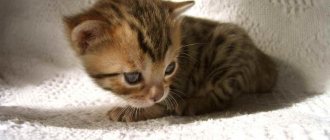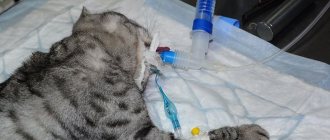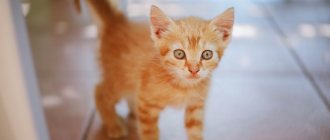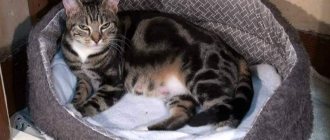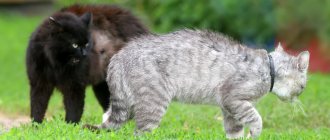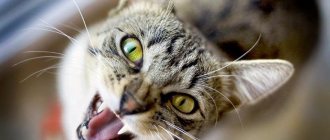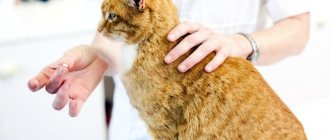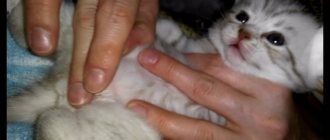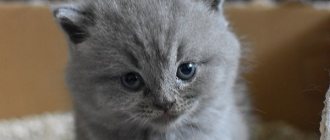Why are kittens born blind?
When a kitten is born, its body is not fully formed. Some organs, including the eyes, continue to develop for some time after birth.
Each fetus in the womb is in a special bladder into which it secretes its waste products. Tightly closed eyelids protect the organs of vision from harmful impurities. And after birth, it takes time for the eyes to adapt to external stimuli.
Why with open
When puppies open their eyes after birth
Most often, only sphinxes can be born with open eyes; in other cases, the birth of babies with open eyes is the result of a disorder during pregnancy. It looks a little strange or even scary, but you shouldn’t immediately rush into panic or sign the little ones’ death warrant. In this case, you need to move the cat with the litter to a dark place and protect the delicate tissues of the eyes from mechanical damage and light for two weeks, since small kittens do not yet know how to blink. You can even trim the claws of littermates so that they don’t accidentally scratch such a baby’s eyes. After fourteen days, eye formation will return to normal, and the baby will grow up sighted and healthy. If the situation has not improved or even worsened, then it is necessary to urgently contact a veterinarian, as vision-threatening diseases leading to complete blindness are possible.
To moisturize the cornea, it is best to use a special gel “Vidisik” (sold in a regular pharmacy). The application scheme is simple: wipe the kitten’s eye with a sterile napkin, apply one drop of gel and gently massage the eye (carefully place two fingers on the edge of the lower eyelid and move in a circular motion to the other side), and then repeat the above algorithm with the other eye. It will be enough to carry out this procedure three times a day to maintain an appropriate level of humidity. Sometimes breeders recommend covering the baby's eyelids with an adhesive plaster, but this may not always help. It is enough just to keep the vulnerable cornea from the harmful effects of bright light and keep it from drying out, and then the visual organs themselves will begin to form as they should.
After how many days do kittens open their eyes?
Kittens are born blind and deaf. It will take several days for the eyelids to open and several weeks for vision to fully develop.
You should not try to open the kitten's eyes. This can lead to vision loss.
The eyes begin to open gradually. First, a small gap appears in the inner corner of the eye. Then the barely noticeable slit increases. This happens on the 3rd day after birth. The eyes look cloudy with a veil. Only after 5-10 days and even 14 days does the cat completely open its eyelids and begin to see blurry. In the first days, babies avoid light because their pupils have not yet adapted to new conditions and do not know how to contract. At the same time, the first milk teeth erupt, which are comparable in sharpness to needles.
The babies in the litter are different. Some kittens' eyes open after birth on the 6th day, others later or earlier. Also, a kitten may have one eye closed longer than the other. This is the norm, so there is no need to worry.
When does eye color appear?
For several days after opening, the kitten’s vision organs have a cloudy bluish tint. The baby does not see, but distinguishes between light and darkness. After a week, the delicate pupil begins to adapt, and it becomes easier for the kitten to tolerate bright light. At this age, everyone's eyes are the same color. Individual pigmentation begins to form at 4 weeks of life and becomes noticeably visible after 3 months.
Full vision appears at the age of about a month.
At approximately 3 months, it begins to change based on the breed and color of the animal. For each breed, this period is individual and can fluctuate up or down. The final color of the eyes is formed by six months of the animal’s life. In Siamese kittens it is brightest during adolescence and fades as they grow older.
How do kids see?
Even if by 10-14 days the kittens open their eyes completely, their vision is still poor. They begin to see clearly only after 2 months. And all this time they understand what is happening only by relying on the smell, the feeling of warmth from their mother and littermates.
At 3 weeks, vision begins to improve. At 1 month, the kitten sees objects almost clearly in order to avoid bumping into them. But the baby is still clumsy, as eye-paw coordination has not been established. At the age of 1.5 months, he sees well enough to find food or bypass some object in his path.
Cats are good mothers. They take full care of the offspring and ensure their cleanliness. The owner’s task is not to disturb the cat, but also to regularly examine the babies in order to take timely measures.
Kittens in the first week of life
Newborn kitties in the first week of their life are absolutely helpless: they cannot see (at birth their eyes are closed), hear (because the ear canals are blocked) and cannot even walk. They crawl slowly and chaotically in search of their mother's nipple. For the first 20 days of life, kittens need exclusively maternal care and warmth, since their body temperature is much lower than that of adults and thermoregulation is still poorly developed.
With the birth of offspring, cat owners often build a place where the new mother spends all her time with the babies, so that they do not crawl away or no one accidentally steps on them. This could be a large cardboard box with bedding. The only thing the owner can do to help the cat during this period is to keep the box clean, because if the cat finds the bed dirty, it will take its children to a more favorable place.
What determines the timing of eye opening?
The timing of the opening of the eyes depends on several factors – the breed, how long the cat’s pregnancy lasted, and living conditions.
Breed affiliation
It is believed that Orientals (Siamese, Abyssinians, Orientals) develop faster. Also, development occurs at a faster pace in short-haired cats compared to long-haired cats.
Sphynxes are often born with their eyes slightly open. And already after 2-3 days they open them completely. On days 3-5, the eyelids of Rex cats (Devon Rex, Cornish Rex) open. Regular kittens remain mole rats for an average of 7 days.
Large breeds take longer to “grow up” - British Shorthair, Norwegian Forest, Maine Coon, Siberian. Big cat kittens open their eyes at 6-10 days. And for ragdolls it is quite normal to see sight on the 14th day or later.
Gestation period
On average, a cat's pregnancy lasts 63 days. But it is a common occurrence that deadlines move 1-2 days earlier or 2-4 days later. If a cat is overbearing and the kittens are born at 68-70 (this is already a caesarean section), then their eyes may be slightly open, since babies develop very quickly in the womb.
Features of breeds
Maine Coon
This is the largest long-haired breed native to the United States; adult individuals reach a normal weight of 12 kg. The Maine Coon is also larger than other breeds at birth. Moreover, girls are significantly behind boys in size. The Maine Coon's color is typical of domestic cats. The thick, long coat is adapted to cold climates, but it requires constant care. To prevent the fur from rolling, it needs to be combed. Maine Coons have tufts at the tips of their ears, making them look like lynxes. The breed is friendly and gets along well with family members and other animals in the house. Cats are distinguished by good health, the average life expectancy is 13 years. However, breed-specific diseases cannot be excluded. In kittens it may be spinal muscular atrophy. Appears at the age of 3-4 months. A genetic disease accompanied by the kitten's body swaying when walking, or the kneecaps touching each other in a static position. It needs to be treated immediately. The only way to diagnose, other than obvious symptoms, which are not a basis for diagnosis, is to test the cat's DNA. Obvious symptoms may be a reason to conduct a full examination.
Maine Coon kittens
adult Maine Coon
British cat
Popular breed. Cats are good-natured and calm, suitable for those who love peace. Adults are independent and extremely reserved. At the same time, kittens are quite active and mobile and require constant attention. In the first pregnancy, a mother cat can bring 2-3 kittens, in subsequent ones - 4-5. Although in the first month of life the baby will have time to fully develop, and may even be able to eat and go to the litter box on his own, it is not worth separating him from his mother. Early weaning can lead to illness. It's better to wait two or three months. Kittens that have lived with their mother for more time are calm and emotionally stable in nature. Month-old cubs have a strong, squat build, thick paws, and a rounded head. At three months, a period of active growth and elongation begins; the young cat loses the solidity of its appearance, but over time the body takes on the appearance characteristic of the breed. The breed is suitable for people who are away from home for a long time. The British cat will not be too sad from loneliness.
British cat
British cat
Sphinx
The most unusual cats in their appearance, similar to alien creatures. The absence of wool is their main feature. Hence the problem inherent in the breed - fear of cold. The optimal temperature for them is 25 degrees and above; they cannot tolerate life on the street. Prolonged exposure to the sun is also undesirable for the Sphynx, because the skin can get burned. Cats of this breed are sociable by nature, love to be the center of attention, and get along with children. They can even live with parrots, since they lack a hunting reflex.
The eyes of sphinxes have a significant drawback: they do not have eyelashes, which means there is no way to protect their eyes from dust and dirt. Cleaning the eyes with special lotions is necessary. Perhaps the lack of cilia is a consequence of the fact that kittens are sometimes born with their eyes open. Sphinx kittens often open their eyes a day or two after birth. Otherwise, they require the same care as other domestic breeds.
Sphinx
What to do if your eyes do not open on time
If one or more kittens from the litter seem to have their eyes stuck together, you can try to help and “soak” them. To do this, use tea leaves. You need to soak a cotton pad in tea and apply it to your eyelids. When the baked crust gets wet, very carefully try to push your eyelids apart with your fingers. Also, in order to remove the crust on the dried eyelids, purulent discharge, use the ophthalmic drug Ofto-Lavas and other similar products.
Not as common, but may require consultation with a veterinarian. If kittens' eyelids do not open after 2 weeks of life, there is a risk that the baby is sick.
Any bacterial infection, herpes virus, transmitted from mother to fetus or after birth, can cause conjunctivitis - inflammation of the mucous membrane. If the eyelids are still closed, then the pathogenic microflora finds a favorable space under them and multiplies intensively. The eyelids turn red and swell. If the eyes begin to open slightly, then purulent discharge is possible. Conjunctivitis requires serious treatment, as it can lead to blindness.
The reason why a kitten's eyes do not open is keratitis or inflammation of the cornea, which developed under a closed eyelid. As well as congenital fusion of the eyelids (partial or complete). In this case, only surgical treatment is provided.
Possible problems and methods for eliminating them
The timing of eye opening can be affected by inflammatory processes in the visual organs, as well as congenital or acquired pathologies.
Fusion of eyelids
Fusion refers to the individual characteristics of the body of some individuals and is rare. If eyelid opening is not observed within a month after birth, the owner needs to sit the kitten in front of him and lightly simultaneously pull the upper and lower eyelids of first one eye, then the other, to diagnose the problem.
You can get rid of the fusion with massage. However, in most cases, surgery is used. The eyelids are cut under anesthesia. For rapid healing, special medications are used.
Conjunctivitis
Conjunctivitis is an infectious disease that is caused by various microbes. Bacteria can enter the body of a newborn kitten before the animal can see. The main symptoms of conjunctivitis include watery eyes and swelling of the eyelids.
The owner can help his pet on his own if the disease is not advanced. Strongly brewed black or green tea is used to wash the eyes. It is necessary to moisten a cotton swab in tea and wipe the kitten’s eyes. The medicine can be instilled using a pipette. In more severe cases, you need to contact your veterinarian to prescribe drug therapy.
Why does the kitten have slanted eyes?
When kittens begin to see, the owner sometimes notices a strange picture - their eyes look in different directions. Strabismus is a common phenomenon and should not be alarmed. The fact is that newborn kittens are not yet able to control their muscles. They need time to learn to focus their gaze and direct both eyes in one direction. Babies acquire a meaningful look by 5-6 weeks, and some purebred cats only by 10 months. If the strabismus does not go away, you need to see a veterinarian.
My eyes don't open on time, what should I do?
If kittens are kept in a bright room, their eyes will develop more slowly than usual and will take longer. The eyes of long-haired individuals open with a considerable delay from the others. In such cases, there is no need to worry, you just need to wait. But sometimes closed eyes signal illness.
If an infection occurs, conjunctivitis may develop. The kitten does not open its eyes because they are stuck together due to the secretion of mucus and pus. The eyelids and surrounding areas become red and swollen. In this case, constant eye rinsing is required. Treatment should be done promptly to minimize damage. To lift the eyelids, you need to carefully apply a moistened cotton swab to the eye to soften the suppuration. Then, from the outer corner of the eye to the inner corner, wipe the eye with a cotton pad with warm saline solution to remove all infected discharge from the eye area. Veterinarians prescribe antibiotic drops or ointments to treat conjunctivitis in addition to oral medications. Treatment usually lasts from one to four weeks.
conjunctivitis in kittens
Microphthalmia (underdeveloped eyeballs) or anophthalmia (absent eyeballs) are rare but can also cause a newborn's eyes not to open. With microphthalmia, poor vision can still develop; with anophthalmia, the kitten will remain blind forever. However, blind cats can lead happy lives if their lifestyle is adapted to their needs.
Microphthalmia of the eye
Possible problems
Before the kitten is 3 weeks old, there is no reason to worry about the eyes not opening. However, careful observation of babies will allow you to detect existing deviations in time. It can be:
- Fusion of eyelids. In this case, the eye sockets swell, and purulent discharge is found on the edges of the eyelids. If the fusion is partial, a light massage will help. First, the eyelids are soaked with tea leaves. After the procedure, wipe with boric alcohol. Complete fusion, when the eyelids are closed tightly, requires surgery.
- Conjunctivitis. The disease can occur as a result of an infection or injury. The eyelids swell and stick together due to dried purulent dark brown discharge. To soften the pus and remove it, use a weak tea solution. The procedure for cleansing the eyelids is carried out several times during the day. Instead of tea, you can use special pharmaceutical solutions that will be selected by your veterinarian. Usually after 2 days the eye condition improves. If this does not happen, a laboratory study of the discharge is carried out to identify the causative agent of the pathological process. Subsequent treatment is based on the results obtained.
- The birth of a completely blind kitten is quite rare. Usually the congenital defect is compensated by more developed other senses - hearing, smell. Such cats are very well oriented in space and are almost no different from healthy ones.
If there are no signs of inflammation, there is no need to worry about kittens’ eyes not opening for a long time. This means we need to wait a little longer.
BRITISH KITTENS – from 0 to 4 months1 day of life - the kitten is born completely blind, but he very quickly develops a sense of smell and touch, thanks to which he quickly finds a source of food. Crawling - immediately after birth, shaking his little body and bumping into brothers and sisters. It distinguishes light and shadow well - it shudders when a new bright light source appears. Snorts funny! Without seeing or hearing anything, babies have a developed sense of smell and touch - they find their mother cat’s nipples by smell! It is convenient to keep kittens in a cardboard box, which I always cover on top with a light or warm (depending on the time of year and temperature in the room) blanket. For two weeks (before the eyes open), kittens should live in almost complete darkness, and even after the eyes have opened, the kittens should not be brought into bright light. The box should be placed in a place where there are no drafts.
3 - 5 days of life - the kitten begins to hear! Defends his right to the nipple, pushing away his brothers and sisters. It is interesting that most kittens do not suck all nipples in a row, but choose one, taking it into their mouth, they massage the mammary gland with their front paws, causing it to lactate more abundantly. The shivering reflex is absent in the first 6 days, so kittens are completely dependent on maternal warmth to maintain the required body temperature.
Defends his right to the nipple, pushing away his brothers and sisters. It is interesting that most kittens do not suck all nipples in a row, but choose one, taking it into their mouth, they massage the mammary gland with their front paws, causing it to lactate more abundantly. The shivering reflex is absent in the first 6 days, so kittens are completely dependent on maternal warmth to maintain the required body temperature.
6-14 days - the eyes open, first in the first baby born, then in the rest, first in the form of a slit, then, after a couple of days, completely. After 14 days of life, baby teeth begin to grow, at 3-4 weeks, fangs grow. We weigh each kitten every day until they are 2 weeks old and monitor their growth . All data is recorded in a separate notebook created specifically for this purpose.
Starting from 4 weeks , the kitten begins to walk, but coordination of movements is not yet fully developed; quickly becomes active, plays, explores the world around him, the kitten seems clumsy. Gradually, facial expressions and gestures become expressive: when strangers approach, the baby slightly arches its back, taking a defensive pose, presses its ears to its head, crouches to the ground, its fur stands on end, a quiet hiss is heard... I really love this period of kittens’ lives! These are the little ones, warm, soft and smelling deliciously of milk:
If there are many kittens in the litter and the mother cannot cope, and also given that the kittens have teeth and each feeding of numerous offspring causes pain in the mother cat, you can start feeding the babies . And our assistant in this is a substitute, as close as possible in its properties to cat milk, for example, such as Royal Canin Babycat Milk . To be honest, the activity is not quick and requires a lot of care and love. The nipples included in the kit with milk, unfortunately, are not suitable, and I recommend feeding kittens through a syringe without a needle, but here you need to be careful not to injure the baby’s delicate mouth. It is also important that the food is warm, not hot or cold. In small containers, food cools quickly, so it is better to keep the formula in a large container at the right temperature (i.e. in a water bath) during feeding. It is useful to know that this milk can also be given to a nursing cat. This is how it was with the litter “A”, in the 3rd week of the babies’ life. Grechenka was tired and I helped her recover: I took over the 1st day of feeding completely, and then we set up a duty and fed in turns:
From 4 weeks of life, kittens begin to be fed with “adult” food; this is a special time for a kitten. We need to teach him to eat and drink in a completely different way than he is used to. Twice a day: in the morning and in the evening, the kids each receive their own portion of pate and dry food is placed in the enclosure - the kittens first try to “bury” it, then they gradually get used to the smell and crack it with pleasure. At the same time, without completely refusing the services of your beloved mother.
45 days of life - the British kitten acquires a beautiful body shape, has good coordination of movements and already needs space to play. The enclosure is expanded, a scratching post is added, and gradually, step by step, in a limited manner and exclusively under the close attention of a person, access to the playhouse is opened. All these safety measures are related to the fact that kittens, which are still unintelligent, can easily climb up, but they need to be taught to go down so as not to sprain their ligaments.
And at 1.5 months the first “outing” is made - the litter is certified , when the quality of each baby is determined, obvious defects are identified, and the potential class of the kitten is determined. In our nursery, certification is carried out by an international category judge, candidate of biological sciences and a wonderful person, Inna Vladimirovna Shustrova , so each certification is like a mini-exhibition: and the choice of best of best and comparisons, the event is fun and very interesting, for which many thanks to Inna Vladimirovna! Based on the act of certification and registration of the litter, the kitten is given a certificate with an individual number.
From this moment on, the little tiny kitten becomes a full-fledged cat personality - a British Shorthair - and has not only a mustache and a tail as a document!
From about 1.5 months, it becomes no longer possible to hold young growing organisms; they easily jump over the enclosure, which is 1.2 meters high. And our task is to prepare the rooms for the raid of very curious kids: plug all the holes, remove vases, figurines and everything that could harm the kids. That's it, the enclosure is cleaned and the whole room is given to the kittens! Here's the joy!!!
a few photos of British kittens from our everyday life:
Grow up healthy and cheerful, kids!!!
